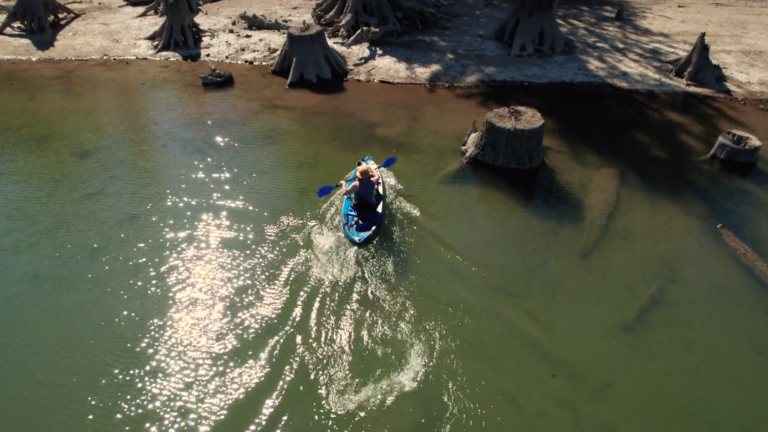Life is full of obstacles that are seemingly impossible to overcome, at least at the initial glance.
As you probably know full well, with a careful approach and some hard work, nothing is truly impossible, and eventually, anyone who wants it hard enough succeeds.
Of course, you need a little bit of luck here and there but it will happen to you if you make sure you do everything in your power and never give up.
Things are pretty much the same when kayaking is concerned too, and in more ways than one. As a beginner, you know nothing about the activity and it seems overwhelming and difficult.
Then you get your kayak, start paddling, and soon realize that it was never that hard. You were just a complete beginner who was not sure what to do and how to do it.
However, there are some actual obstacles when kayaking is concerned that cannot be overcome. In certain situations, you have to find another way and avoid them entirely.
Table of Contents
TogglePortaging Kayaks

It does not happen that often, but it is always a real possibility. Kayaking is usually done in rivers, both large and small.
Larger and wider rivers are normally easy to navigate, but the smaller ones can be particularly tricky.
Sometimes, the entire section of the river can be blocked off and therefore unpassable in a kayak.
The path is typically blocked by a fallen tree, a large branch, or some rocks that have rolled down recently.
It can also be a man-made object like an old vehicle, a bunch of tires, barrels, etc.
Regardless of what it is, the object is stuck and blocking the way for anything big. And a paddler in their kayak qualifies as big. The water can still go through and it usually does without much issue.
It does however create dangerous situations known as strainers as it passes through the openings with anything else being trapped.
If a section of the water you are trying to navigate is blocked off like this, the only thing you can do is get out of the river and use the land to go around it.
This is called portaging, as you portage a kayak across dry land.
How to Do It?

From the looks of it, to portage a kayak does not seem to be the optimal way of going down the river. It is considered a hindrance because it disrupts the very nature of the activity.
You are supposed to be in the water, paddling away and enjoying the experience. Sometimes, the universe throws a curveball and you have to go out on land and carry the kayak.
So what is the right way to do it and is there even the right and wrong way of portaging your paddling boat? There is, and it is quite important to do it right.
Planning the Route

Before you even come to the body of water in question, there needs to be a route planned out. Your kayaking adventure experience will suffer if you fail to map out the journey and do some research.
Obstacles can appear out of nowhere, but there should be reports and reviews for any river you want to navigate.
Figure out where you could portage in advance and it will be much easier.
Walk the Route Beforehand

Once you are there, it is a good idea to walk the route before starting kayaking. The portaging route may not need to be used in the end, but you should walk it before actually needing it.
Find out about where and what could be the issue so that you prepare. Looking over your shoulder constantly as you paddle is not the ideal way to enjoy the route.
Therefore, look for fallen trees and any other debris that may be difficult or impossible to go through. When you start approaching it later, you will know exactly where to disembark and walk around it.
Care for the Gear

Preparing for an eventual portage is troublesome because of all the gear kayakers usually have with them. The fact that you need to carry the kayak means that the gear will have no place to securely sit.
It all needs to fit in your backpack or be safely stored in/on the kayak. Remember, portaging involves carrying the kayak and you cannot carry a heavy craft filled to the brim with gear.
Some of it will have to go into a bag or two, while lighter equipment can be put under bungee strings and inside the seal hatch storage. Plan this in advance so that your walk is easier and quicker.
Never Drag the Kayak

The number one mistake kayakers make when they portage for the first time is dragging the kayak behind them.
They pick up the bow or the stern and drag the other one behind. This is not a good idea as it will damage your boat beyond repair.
It is also a good way to lose some of the gear that is still in the kayak. Instead of this, you have to carry it on your shoulder or have someone help you carry it in a team effort.
It is not easy, but the best way is to lift it up over your head, holding it upside down with the cockpit directly above.
Most paddlers lift it up sideways with their dominant arm inside the cockpit, and their other arm helping to support it. Either onto your head or over your shoulder with your arm inside is how you do it.
Bring a Trolley
Last but not least, you can also invest in a special kayak trolley that will help you move it around regardless of the situation.
It is not always the best idea though as it is heavy and cumbersome, and it needs to be in your kayak at all times.
The trolley is the best solution when you are absolutely expecting a portage situation and you know that the terrain will not be that rough for the wheels.
For an off-road situation, the trolley needs off-road wheels that can take all the rock and dirt.
Meet Maria Alexander, the fearless adventurer steering the ship at KayakPaddling.net. Her mission? To convince you that life’s too short for dry land and that the best stories always start with “So there I was in my kayak…”
Related Posts:
- 16 Best Kayak For Beginners 2025 - Kayaking Adventure Gear
- Heavy Duty Fishing: 11 Best Rods And Reels For Big Fish 2025
- 10 Best Fish Finders Under $200 2025 - Top Affordable Picks
- 10 Best Kayaks For Camping 2025 - Lightweight and…
- 10 Best Inflatable Kayak 2025 - Rivers, Lakes & Open Seas
- 12 Best Motorized Kayak 2025 - Start Your Aquatic Adventure!












